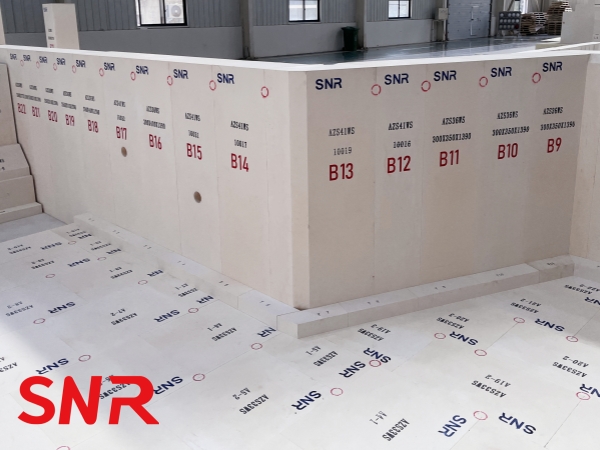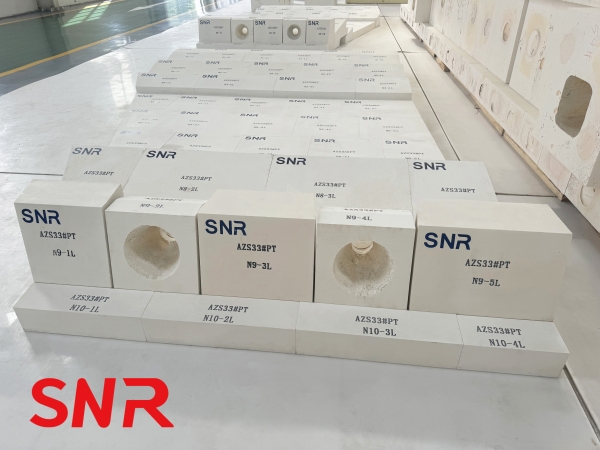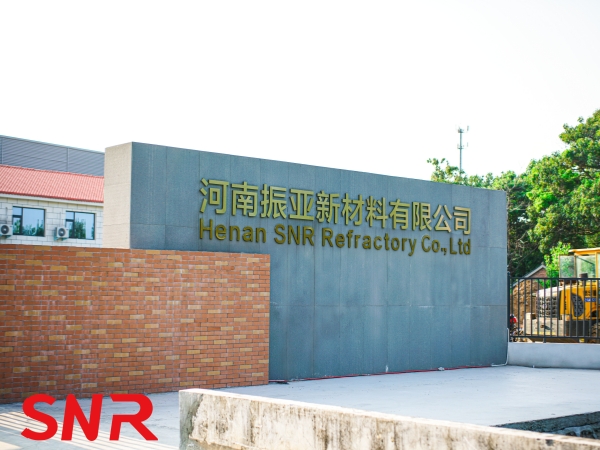
Fused cast AZS block has become an indispensable refractory material in glass furnaces because of its high refractoriness, strength, and erosion resistance. However, in extreme environments, the performance and life of fused cast AZS blocks are often seriously affected. This paper will discuss the challenges of fused cast AZS block in extreme environments from the perspectives of high temperature, high pressure, and strong corrosion, and put forward specific solutions.
In the high-temperature environment, as an important high-temperature resistant material, the fused cast AZS block faces many challenges, especially in thermal expansion, thermal stress, and thermal shock stability. These challenges not only test the material and structure of the fused cast AZS block but also directly affect its reliability and life in the high-temperature operating environment.
We can see that the high temperature will cause significant thermal expansion inside the fused cast AZS block. As the temperature increases, the vibration between atoms or molecules inside the fused cast AZS block intensifies, resulting in volume expansion. If the coefficient of thermal expansion of the component materials of the fused cast AZS block is inconsistent, or its internal structural design is unreasonable, it will produce uneven thermal expansion at high temperatures, and then accumulate stress inside the material. This thermal stress caused by temperature difference is the main cause of cracking and spalling of fused cast AZS blocks. Once the thermal stress exceeds the bearing limit of the material, it will lead to structural damage of the fused cast AZS block and seriously affect its performance.
Then, the thermal stress problem is particularly significant in high-temperature operating environments. Because fused cast AZS blocks often need to work at high temperatures for a long time, and are usually accompanied by sharp changes in temperature, this further aggravates the generation and accumulation of thermal stress. When the fused cast AZS block is cooled rapidly from a high-temperature state, huge tensile stress will be generated inside, and this stress is concentrated in the weak parts of the material, such as grain boundaries, pores, or around inclusions, which is easy to lead to the formation and expansion of cracks. Once the crack occurs, it will accelerate the spalling and damage of the material, ultimately affecting the integrity and service life of the fused cast AZS block.

In addition, the lack of thermal shock stability is also a major challenge faced by fused cast AZS blocks in high-temperature environments. Thermal shock stability refers to the ability of a material to maintain its structural integrity while undergoing rapid temperature changes. For fused cast AZS block, the frequent temperature change will have a sharp impact on its internal structure, resulting in a sharp change in thermal stress. If the thermal shock stability of the fused cast AZS block is poor, it will not be able to withstand this frequent temperature change, resulting in cracking, spalling, or even destruction under the action of thermal stress. Especially in high-temperature metallurgy, glass manufacturing, and other industries, fused cast AZS blocks often need to withstand extreme temperature fluctuations, so improving their thermal shock stability is essential to ensure the long-term stable operation of the equipment.
(1) Optimizing the ratio of raw materials is one of the key measures to improve the thermal stability and thermal shock resistance of the fused cast AZS block. The selection of raw materials, through fine adjustment of the proportion of various components, can significantly affect the physical and chemical properties of the fused cast AZS block. Specifically, increasing the proportion of high melting point raw materials, such as the use of high melting point minerals such as zirconite and alumina, can effectively improve the melting point of the fused cast AZS block, so that it can still maintain the stability of the structure at higher temperatures. At the same time, the introduction of raw materials with low thermal expansion coefficients, such as some specific silicate or aluminate, can significantly reduce the thermal expansion rate at high temperatures, reduce the thermal stress caused by uneven thermal expansion, and thus enhance its thermal shock resistance.
(2) Improving the manufacturing process is another important way to improve the high temperature resistance of fused cast AZS blocks. The traditional manufacturing process often has some problems, such as uneven density, high porosity and loose structure, which will seriously affect the high temperature resistance and mechanical strength of the fused cast AZS block. Therefore, using advanced manufacturing process, the raw materials can be uniformly compacted under high pressure environment to produce higher density and more dense structure of the fused cast AZS block.
(3) Surface treatment technology is also of great significance for improving the high-temperature resistance and thermal shock resistance of fused cast AZS blocks. By applying a coating or other surface treatment on the surface of the fused cast AZS block, a protective layer can be formed to effectively isolate the direct contact between the high-temperature environment and the fused cast AZS block matrix, thereby reducing the thermal stress and corrosion rate. The material selection of the coating is critical and usually requires excellent high-temperature resistance, good chemical stability, and good adhesion to the substrate. For example, ceramic coating is an ideal choice for the surface treatment of fused cast AZS blocks due to its high melting point, good chemical inertness, and excellent thermal shock resistance. In addition, advanced technologies such as thermal spraying can also be used to form a uniform and dense coating on the surface of the fused cast AZS block to further improve its high-temperature resistance and thermal shock resistance. These surface treatment technologies not only enhance the protective ability of the fused cast AZS block but also provide a strong guarantee for its application in extreme environments.
In high-pressure environments, the challenges faced by fused cast AZS blocks are particularly severe, and these challenges mainly focus on mechanical stress, wear, and spalling. High-pressure conditions put a very high demand on the physical properties of fused cast AZS blocks, because it not only requires that fused cast AZS blocks can stably withstand huge external pressures, but also maintain the integrity and durability of their internal structure.
We can know that the high pressure will cause significant mechanical stress inside the fused cast AZS block. This stress is caused by the interaction between external pressure and the internal structure of the fused cast AZS block, which will form a complex stress distribution inside the fused cast AZS block. When these stresses exceed the withstand limit of the fused cast AZS block material, tiny cracks will occur inside the material. Once these cracks are formed, they will continue to expand under the continuous action of high pressure, and eventually lead to the fracture or spalling of the fused cast AZS block. The effect of mechanical stress is one of the main reasons for the failure of fused cast AZS blocks under high pressure.

However, friction and wear in high-pressure environments is another important challenge for fused cast AZS blocks. Under high pressure conditions, the contact between the fused cast AZS block and other components will be closer, and the friction effect will be more significant. This continuous friction will cause the material on the surface of the fused cast AZS block to gradually wear out, forming wear marks. With the passage of time, this wear will gradually increase, and eventually lead to a large area of the material on the surface of the fused cast AZS block. Such wear and peeling will not only reduce the service life of the fused cast AZS block, but also may have a negative impact on its performance, such as reducing insulation performance or increasing the risk of leakage.
(1) Enhance structural design: In terms of optimizing the structural design of fused cast AZS blocks, we can adopt a variety of strategies to improve its compressive strength and wear resistance. An effective method is to add reinforcing bars, which can disperse and resist the mechanical stress brought by high pressure, and prevent the fused cast AZS block from cracking due to excessive pressure. At the same time, the use of composite structure is also a wise choice. By combining materials with different properties, the advantages of each material can be fully utilized to form a complementary effect, thereby improving the overall performance of the fused cast AZS block. For example, high-strength, high-hardness materials can be used in the key parts of the fused cast AZS block to enhance its compression and wear resistance.
(2) Selection of high-strength raw materials: The selection of raw materials is crucial to the performance of the fused cast AZS block. In order to further improve its compressive performance and wear resistance, we should choose raw materials with high strength and high hardness. Alumina and zircon sand are two ideal options. Alumina is widely used in the manufacture of fused cast AZS blocks because of its high melting point, high hardness and good chemical stability. It can significantly improve the compressive strength and wear resistance of the fused cast AZS block, so that it can run stably in high pressure environment for a long time. Zircon sand is known for its excellent high temperature resistance and thermal shock resistance, which can further enhance the heat resistance and spalling resistance of the fused cast AZS block.
(3) Strengthen maintenance and maintenance: Regular maintenance and maintenance of the fused cast AZS block is the key to ensure its long-term stable operation. Should establish a set of sound maintenance and maintenance system, regular inspection and cleaning of fused cast AZS blocks. In the inspection process, special attention should be paid to observe whether the surface of the fused cast AZS block has cracks, peeling or signs of wear. Once these problems are discovered, immediate steps should be taken to repair or replace them to prevent the problem from worsening. In addition, cleaning the ash is also an important part of maintaining the performance of the fused cast AZS block. Ash accumulation will not only affect the heat dissipation performance of the fused cast AZS block, but also accelerate its wear and aging. Therefore, we should regularly clean the ash on the surface of the fused cast AZS block to keep it clean and dry.
As a key material in strong corrosive environment, fused cast AZS blocks are faced with severe challenges from chemical erosion, penetration and dissolution. This highly corrosive environment is usually composed of various acidic, alkaline or oxidizing substances, which have a strong erosion ability and can cause serious damage to the structure and performance of the fused cast AZS block.
First of all, chemical erosion is one of the main threats faced by fused cast AZS blocks in strong corrosive environment. These corrosive substances can react with the chemical composition of the surface of the fused cast AZS block, resulting in gradual peeling and corrosion of the surface layer. Over time, this erosion will gradually penetrate deep into the interior of the fused cast AZS block, further damaging its structural integrity. This will not only reduce the mechanical strength of the fused cast AZS block, but also may affect its electrical and thermal conductivity properties, which seriously affects its effect in practical applications.
Secondly, the problem of penetration is also a problem that needs special attention in the strong corrosion environment of electric fused cast AZS blocks. Corrosive substances can often penetrate into the interior of the fused cast AZS block through tiny pores or cracks, and react with its internal chemical composition. This kind of penetration not only intensifies the corrosion degree of the fused cast AZS block, but also may lead to more serious consequences, such as the destruction of the internal structure and the sharp decline in performance. Once the interior of the fused cast AZS block is seriously corroded, its overall performance will be greatly reduced, and even may completely fail.
Finally, the problem of dissolution is also one of the challenges faced by the fused cast AZS block in the strong corrosion environment. Some corrosive substances have a strong dissolving ability and can dissolve some components in the fused cast AZS block, resulting in significant changes in the structure and performance of the fused cast AZS block. This dissolution will not only affect the service life of the fused cast AZS block, but also may cause pollution and harm to its surrounding environment.
(1) The selection of corrosion-resistant raw materials is the primary strategy to improve the corrosion resistance of fused cast AZS blocks. Among many raw materials, zircon sand is an ideal choice to enhance the corrosion resistance of fused cast AZS blocks because of its high melting point, high hardness and excellent chemical stability. The composition of zirconia in zircon sand can effectively resist the erosion of a variety of strong acids, strong alkalis and molten metals, ensuring that the integrity of the structure and the stability of the performance of the fused cast AZS block can be maintained in extreme environments.
(2) The use of corrosion resistant coating as an additional protective layer can further enhance the protective effect of the fused cast AZS block. Because of its excellent high temperature resistance and corrosion resistance, ceramic coating can effectively isolate the direct contact between corrosive substances and the matrix of the fused cast AZS block, and slow down the corrosion process. The glass coating, because of its good sealing and chemical inertness, can form a solid barrier on the surface of the fused cast AZS block to prevent the penetration and dissolution of corrosive liquids. When selecting the coating material, it is also necessary to consider its compatibility with the matrix of the fuse brick to ensure that there is good adhesion between the coating and the matrix to avoid the coating falling off due to long-term exposure to the harsh environment. Fine coating processes, such as spraying, dipping or sintering, ensure that the coating is evenly applied to the surface of the fused cast AZS block to maximize its protection.
(3) Optimizing the use environment is another important way to reduce the corrosion of fused cast AZS blocks and extend the service life. Specific measures include: reducing the concentration of corrosive substances, by diluting or using milder chemical substances to replace highly corrosive substances, reduce its direct erosion of the fuse brick; Control the temperature of the use environment, high temperature will accelerate the chemical reaction rate and increase the corrosion rate, so the appropriate reduction of the operating temperature will help slow down the corrosion process; In addition, keeping the environment dry and clean, reducing the presence of moisture and impurities, can also effectively reduce the corrosion effect. Through comprehensive application of these environmental optimization measures, the corrosion pressure of the fused cast AZS block can be significantly reduced, and its reliability and durability in practical applications can be improved.
The application of fused cast AZS blocks in extreme environments faces many challenges, but these challenges can be effectively solved by optimizing the ratio of raw materials, improving the manufacturing process, strengthening the structural design, selecting high-strength and corrosion-resistant raw materials and using corrosion-resistant coatings. In the future, with the continuous development of material science and manufacturing technology, the performance of fused cast AZS blocks will be further improved, and its application in extreme environments will be more extensive and reliable.

Henan SNR Refractory Co., Ltd(SNR) produces a variety of high-quality fused cast AZS blocks.If you have any needs, please contact us.
 Web:www.snrefractory.com
Web:www.snrefractory.com
Email:moon@snrefractory.com